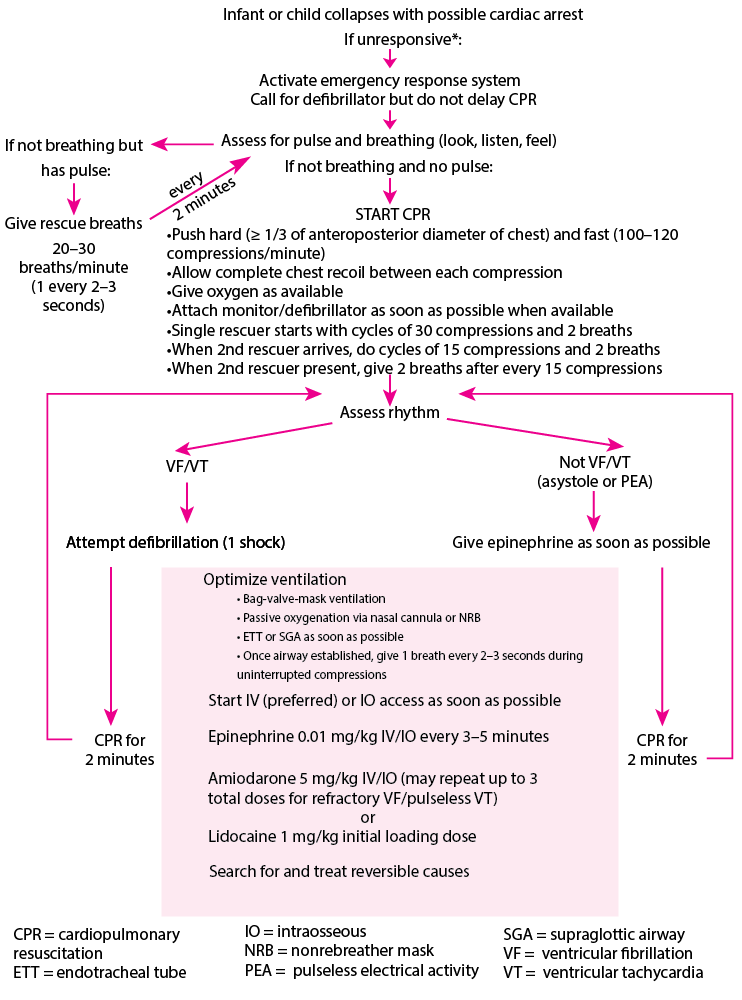Cpr Stands for Depth of Compressions for a Baby Cpr
Pediatric comprehensive emergency cardiac care
| |
| * If an adequate number of trained personnel are available, patient assessment, CPR, and activation of the emergency response system should occur simultaneously. |
| Based on the Comprehensive Emergency Cardiac Care Algorithm from the American Centre Association. |
During breast compressions in infants and children (below the age of puberty or < 55 kg), the chest should exist depressed 1 tertiary of the anteroposterior bore. This is most 4 to 5 cm. In adolescents or children > 55 kg, the recommended compression depth is the same equally in adults, ie, 5 to 6 cm.
Method of chest pinch is also different in infants and children and is illustrated below. The rate of compression in infants and children is similar to that of adults at 100 to 120 compressions/infinitesimal.
Chest pinch in infants and children
A: When 2 rescuers are present, side-by-side thumb placement for breast compressions is preferred for neonates and small infants whose chest can be encircled. Thumbs should overlap if used in very minor neonates.
B: Alone rescuers tin apply 2 fingers for infant compressions. Fingers should be maintained in the upright position during compression. For neonates, this technique results in too low a position, ie, at or below the xiphoid; the correct position is just below the nipple line.
C: Hand position for breast pinch for a child.
(Adjusted from American Heart Association: Standards and guidelines for CPR. Journal of the American Medical Clan 268:2251–2281,1992. Copyright 1992, American Medical Association.)
Blood force per unit area (BP) should exist measured with an advisable-sized cuff, merely direct invasive arterial BP monitoring is mandatory in severely compromised children.
Considering BP varies with age, an easy guideline to remember the lower limits of normal for systolic BP (< 5th percentile) past age is equally follows:
-
< 1 calendar month: 60 mm Hg
-
one month to one year: lxx mm Hg
-
> 1 year: lxx + (ii × age in year)
Thus, in a 5-twelvemonth-old child, hypotension would be defined by a BP of < 80 mm Hg (70 + [2 × v]). Of significant importance is that children maintain BP longer because of stronger compensatory mechanisms (increased heart charge per unit, increased systemic vascular resistance). Once hypotension occurs, cardiorespiratory arrest may speedily follow. All effort should be made to beginning treatment when compensatory signs of shock (eg, increased center rate, cool extremities, capillary refill > two seconds, poor peripheral pulses) are present but before hypotension develops.
Equipment size, drug dosage, and CPR parameters vary with patient historic period and weight (see tables CPR Techniques for Wellness Care Practitioners CPR Techniques for Wellness Care Practitioners Cardiopulmonary resuscitation (CPR) is an organized, sequential response to cardiac arrest, including Recognition of absent breathing and apportionment Bones life support with chest compressions... read more , Drugs for Resuscitation in Infants and Children Drugs for Resuscitation in Infants and Children* Despite the use of cardiopulmonary resuscitation (CPR), mortality rates for out-of-hospital cardiac arrest are nigh 90% for infants and children. Mortality rates for in-infirmary cardiac arrest... read more than , and Guide to Pediatric Resuscitation Guide to Pediatric Resuscitation—Mechanical Measures Despite the use of cardiopulmonary resuscitation (CPR), bloodshed rates for out-of-infirmary cardiac arrest are almost 90% for infants and children. Mortality rates for in-infirmary cardiac arrest... read more ). Size-variable equipment includes defibrillator paddles or electrode pads, masks, ventilation bags, airways, laryngoscope blades, endotracheal tubes, and suction catheters. Weight should exist measured rather than guessed; alternatively, commercially available measuring tapes that are calibrated to read standard patient weight based on torso length can be used. Some tapes are printed with the recommended drug dose and equipment size for each weight. Dosages should exist rounded downwardly; eg, a ii ½-yr-old child should receive the dose for a 2-year-onetime child.
Susceptibility to heat loss is greater in infants and children because of a big surface area relative to body mass and less subcutaneous tissue. A neutral external thermal environment is crucial during CPR and postresuscitation. Hypothermia with cadre temperature < 35° C makes resuscitation more than hard.
Upper airway anatomy is different in children. The caput is large with a pocket-size face up, mandible, and external nares, and the cervix is relatively short. The natural language is big relative to the mouth, and the larynx lies higher in the neck and is angled more than anteriorly. The epiglottis is long, and the narrowest portion of the trachea is junior to the vocal cords at the cricoid ring, allowing the use of uncuffed endotracheal tubes. In younger children, a direct laryngoscope blade mostly allows better visualization of the vocal cords than a curved blade because the larynx is more anterior and the epiglottis is more floppy and redundant. Current available evidence does non support improved patient outcomes from advanced airway interventions as compared to purse-mask ventilation in infants and children during out-of-hospital cardiac arrest.
If there is no avant-garde airway in place in infants and children undergoing resuscitation, the recommended compression:ventilation ratio is thirty:2 if only a single rescuer is present and fifteen:ii if more than than one rescuer is nowadays. This recommendation is in contrast to adults where the pinch:ventilation ratio is always 30:2 and is contained of the number of rescuers.
With an advanced airway in identify, i breath is given every 6 seconds (x breaths/minutes) for infants, children, and adults.
In asystole, atropine and pacing are not used.
-
1. Moler FW, Silverstein FS, Holubkov R, et al: Therapeutic hypothermia later in-hospital cardiac arrest in children. Northward Engl J Med 376:318–332, 2017. doi: 10.1056/NEJMoa1610493
The following is an English-language resource that may be useful. Please note that THE Manual is non responsible for the content of this resources.
Source: https://www.msdmanuals.com/professional/critical-care-medicine/cardiac-arrest-and-cpr/cardiopulmonary-resuscitation-cpr-in-infants-and-children

0 Response to "Cpr Stands for Depth of Compressions for a Baby Cpr"
Postar um comentário